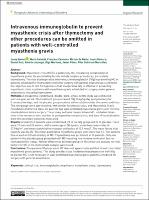| dc.contributor | Vall d'Hebron Barcelona Hospital Campus |
| dc.contributor.author | Gamez Carbonell, Josep |
| dc.contributor.author | Salvadó Figueras, Maria |
| dc.contributor.author | Carmona-Herrera, Francisco |
| dc.contributor.author | Nadal Clanchet, Miriam de |
| dc.contributor.author | Romero Vielva, Laura Maria |
| dc.contributor.author | Ruiz, Daniel |
| dc.contributor.author | Jauregui Abularach, Alberto |
| dc.contributor.author | Pérez Vélez, Javier |
| dc.contributor.author | Suñe Martin, Pilar |
| dc.contributor.author | Deu Martín, María |
| dc.date.accessioned | 2020-02-18T09:12:58Z |
| dc.date.available | 2020-02-18T09:12:58Z |
| dc.date.issued | 2019-07-17 |
| dc.identifier.citation | Gamez J, Salvadó M, Carmona F, de Nadal M, Romero L, Ruiz D, et al. Intravenous immunoglobulin to prevent myasthenic crisis after thymectomy and other procedures can be omitted in patients with well-controlled myasthenia gravis. Ther Adv Neurol Disord. 2019 Jul 17;12:175628641986449. |
| dc.identifier.issn | 1756-2856 |
| dc.identifier.uri | https://hdl.handle.net/11351/4651 |
| dc.description | Immunoglobulin; Myasthenia; Thymectomy |
| dc.description.abstract | BACKGROUND:
Myasthenic crisis (MC) is a potentially life-threatening complication of myasthenia gravis. Its precipitating factors include surgical procedures, particularly thymectomy. The role of preoperative intravenous immunoglobulin (IVIg) in preventing MC in patients scheduled for thymectomy and other surgery with general anaesthesia is unknown. Our objective was to test the hypothesis that preoperative IVIg is effective in preventing myasthenic crisis in patients with myasthenia gravis scheduled for surgery under general anaesthesia, including thymectomy.
METHODS:
A prospective, randomized, double-blind, single-centre study was conducted over a 4-year period. The treatment group received IVIg, 0.4 g/kg/day preoperatively for 5 consecutive days, and the placebo group received saline solution under the same conditions. The two groups were age-matched, with similar functional status, and Myasthenia Gravis Foundation of America class. All patients had well-controlled myasthenia gravis with minimal manifestations before surgery. The primary outcome measured was MC. Intubation times, time in the recovery room, number of postoperative complications, and days of hospitalization were the secondary outcomes measured.
RESULTS:
A total of 47 patients were randomized, 25 to the IVIg group and 22 to placebo. There were 19 men and 28 women, with a mean age of 58.6 years, mean body mass index of 27.8 kg/m2, and mean acetylcholine receptor antibodies of 12.9 nmol/l. The mean forced vital capacity was 84.4%. The mean quantitative myasthenia gravis sum score was 6.3. Ten patients (five in each arm) had a history of MC. Thymectomy was performed in 16 patients. Only one patient in the placebo group presented with MC requiring non-invasive ventilation (but no reintubation) for 6 days. Neither differences between groups in the univariate analysis nor risk factors for MC in the multivariate analysis were found.
CONCLUSIONS:
Preoperative IVIg to prevent MC does not appear to be justified in well-controlled myasthenia gravis patients. This study provides class I evidence that preparation with IVIg to prevent MC is not necessary in well-controlled myasthenia gravis patients scheduled for surgery with general anaesthesia. |
| dc.language.iso | eng |
| dc.publisher | SAGE Publications |
| dc.relation.ispartofseries | Therapeutic Advances in Neurological Disorders;12 |
| dc.rights | Attribution-NonCommercial-NoDerivatives 4.0 International |
| dc.rights.uri | http://creativecommons.org/licenses/by-nc-nd/4.0/ |
| dc.source | Scientia |
| dc.subject | Miastènia greu pseudoparalítica |
| dc.subject | Timectomia |
| dc.subject | Immunoglobulines |
| dc.subject.mesh | Myasthenia Gravis |
| dc.subject.mesh | Thymectomy |
| dc.subject.mesh | Immunoglobulins, Intravenous |
| dc.title | Intravenous immunoglobulin to prevent myasthenic crisis after thymectomy and other procedures can be omitted in patients with well-controlled myasthenia gravis |
| dc.type | info:eu-repo/semantics/article |
| dc.identifier.doi | 10.1177/1756286419864497 |
| dc.subject.decs | miastenia gravis |
| dc.subject.decs | timectomía |
| dc.subject.decs | inmunoglobulinas intravenosas |
| dc.relation.publishversion | https://journals.sagepub.com/doi/10.1177/1756286419864497 |
| dc.type.version | info:eu-repo/semantics/publishedVersion |
| dc.audience | Professionals |
| dc.contributor.authoraffiliation | [Gamez J] Servei de Neurologia, Hospital Universitari Vall d’Hebron, Barcelona, Spain. Vall d’Hebron Institut de Recerca (VHIR), Barcelona, Spain. European Reference Network on Rare Neuromuscular Diseases (ERN EURO-NMD), Newcastle University, UK. Departament de Medicina, Universitat Autònoma de Barcelona, Barcelona, Spain. [Salvadó M] Servei de Neurologia, Hospital Universitari Vall d’Hebron, Barcelona, Spain. Departament de Medicina, Universitat Autònoma de Barcelona, Barcelona, Spain. [Carmona F] Department of Genetics, Microbiology and Statistics, University of Barcelona, Barcelona, Spain. [De Nadal M] Department of Anesthesiology and Intensive Care, Universitat Autònoma de Barcelona, Barcelona, Spain. [Romero, L, Jáuregui A, Pérez J, Deu M] Servei de Cirurgia Toràcica, Hospital Universitari Vall d’Hebron, Barcelona, Spain. [Ruiz D] Department of Anesthesiology and Intensive Care, Universitat Autònoma de Barcelona, Barcelona, Spain. [Suñé P] Servei de Farmàcia, Hospital Universitari Vall d’Hebron, Barcelona, Spain |
| dc.identifier.pmid | 31360225 |
| dc.identifier.wos | 000478600400001 |
| dc.rights.accessrights | info:eu-repo/semantics/openAccess |

